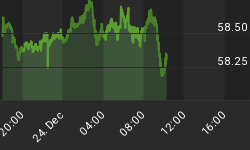Timing attempts to provide market equivalent returns over the long term, with a substantial reduction in variability of returns. The two components of the Timing program are EZ+Macro and Fear/Greed. This system trades rarely and splits its allocations between ETFs tracking the S&P 500, the intermediate-term U.S. Treasuries, and cash.
Information is as of the close on March 20, 2008.
EZ+Macro
My charts are relatively wide, and this site is best viewed at 1280×1024. If the chart is truncated in your browser, click on it to view it in full size.

EZ Trend is now down.

Macro Trend is bullish for Treasuries. This comes into play only if the EZ Trend is not up.
Fear/Greed

The Fear/Greed model signaled a buy for the U.S. stock market in early November, and a sell in December, as the $VIX relative to actual volatility fell to a historically low level. For most of the last three months, the current level of sentiment, as measured by the $VIX relative to actual volatility, has been at levels historically associated with complacency. In the scale of the chart, 80% of the readings since 1990 have been between the red and green lines.
Model Allocation
Based on beginning with a $100,000 portfolio at inception.
S&P 500 SPDRs (SPY) - 24.5%
iShares 7-10 Year Treasury Bond Fund (IEF) - 25.5%
Cash - 50.0%
Returns
Based on beginning with a $100,000 portfolio at inception.
Equity: $97,972.86
Gain, Last 4 weeks: 0.54%
Gain, Year to Date: -3.32%
Gain, Since Inception: -2.03%
These returns include the recent February distribution from IEF of $0.28 per share, and SPY of $0.64 per share.
Changes To Model Allocation
There are no changes to the model allocation since this previous message. It is listed below:
S&P 500 SPDRs (SPY) - 25.0%
iShares 7-10 Year Treasury Bond Fund (IEF) - 25.0%
Cash - 50.0%
Tracking
There are no changes to track.
Commentary
My intuition is that the U.S. stock market has set up for an intermediate-to-long-term bottom, as discussed earlier in the week, but the Timing system is mechanical, and will be tracked based on the signals it generates.















